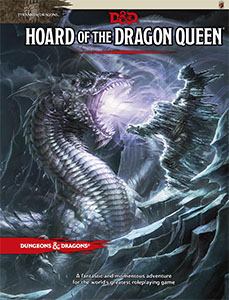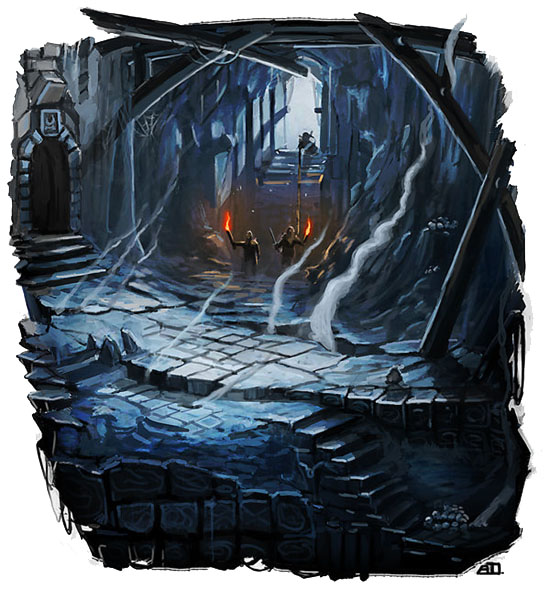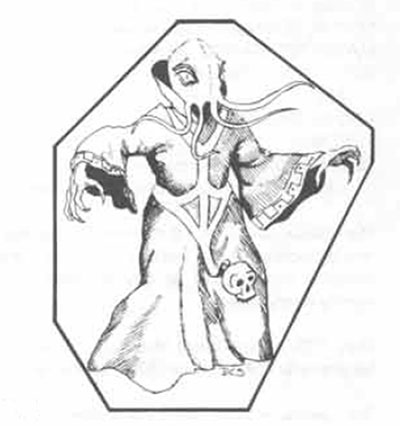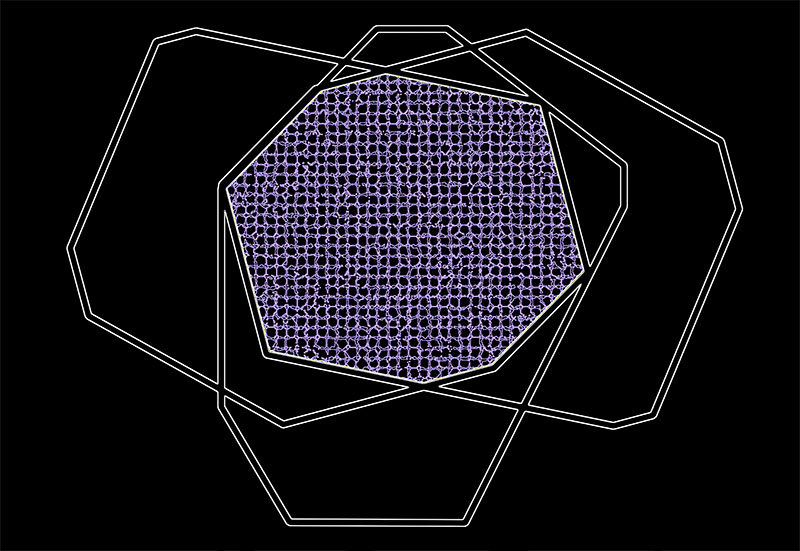 After the review I wrote, several people have asked me whether I’ll be doing a remix of Hoard of the Dragon Queen to “fix” it the same way that I did for Keep on the Shadowfell.
After the review I wrote, several people have asked me whether I’ll be doing a remix of Hoard of the Dragon Queen to “fix” it the same way that I did for Keep on the Shadowfell.
Short answer: Nope.
Why? Because nothing about Hoard of the Dragon Queen made me want to run it. Which means I’m not going to run it. Which means that I’m not going to put the necessary effort into revamping it.
With that being said, while discussing the campaign over the past few days I have had a few thoughts about the approach I would take to remixing the campaign if I were going to do it.
NODE-BASED DESIGN
As I mentioned in my original review, the basic back story of Hoard of the Dragon Queen kinda screams out for a node-based design: Multiple factions of a cult simultaneously pursuing multiple artifacts should lend itself pretty much instantly to the PCs being able to choose which threats they want to prioritize.
One thing to consider, however, is that D&D characters increase in power level over time, so you can’t just have a wide open playing field without risking either crippling difficulty at the beginning of the campaign and/or push-overs at the end of the campaign. With that being said, my understanding of 5E is that the “bounded accuracy” design is specifically meant to increase the range of tolerance for this sort of thing and pre-4E had at least a 3-4 level range of tolerance.
So what you need to do is design around funnels that refocus the investigation. (Or, alternatively, layer cakes while accepting that occasionally the PCs will backtrack and roll over some easier material.)
Having a bulkier initiating node that the PCs can gain a couple of levels during also makes sense (to take the edge of fragility off their characters). So it makes sense to keep the general idea of “siege on Greenest, followed by investigations at the cult camp.” In the camp you’d want to seed clues to three different nodes:
- Leads to wherever they’re transporting the stuff.
- An envoy from another faction of the cult.
- Reports from agents who are currently spying on a third faction of the cult (that somehow threatens this faction’s interests).
This 1st Funnel is primarily focused on figuring out what the cult’s true agenda is. The second prong of clues within the scenarios of this funnel, therefore, would show their fascination with Tiamat, hint that they’re looking for Tiamat-themed artifacts, and also reveal the “five-headed” structure of the cult. The first prong is the structural branch in which clues point them to the conclusion of the 1st Funnel: An “all-faction” meeting of the cult. At this meeting, the PCs would discover (or verify) that the cult is specifically interested in the five dragon masks. Furthermore, they would get clues pointing them towards 2-4 more dragon masks. These might include:
- Ongoing expeditions being run by the cult.
- Expeditions that are about to begin. (Do the PCs sabotage the mission? Race to meet them to the site?)
- Fortresses where the cult is keeping masks they have already obtained.
And so forth. This 2nd Funnel would lead them to Tiamat’s Prison where the final ritual is being performed (or whatever). If I was invested in the idea of the cult getting all five masks and raising Tiamat, I’d probably arrange things so that the masks have already been shipping to the final site before the PCs ever arrive at the various expedition locations. Given my predilections, however, what I’d probably do is design the ritual in a way that the PCs holding a single mask won’t completely disrupt it. Maybe something like:
- Each mask allows the cult to summon one Aspect of Tiamat (i.e., a deity-infused dragon of matching color). Or maybe the ritual just involves an appropriate dragon wearing the mask and, thus, channeling a shard of Tiamat’s soul. Either way, the point is that if the PCs manage to hold onto one or more of the masks… great! They have substantially reduced (but not eliminated) the effectiveness of the plans and Tiamat’s manifestation on this plane.
- Also designing 2-3 proactive nodes of assassins or thieves or the like that the cult would send after the PCs in order to retrieve the masks they’ve “stolen”.
USING THE RAW MATERIAL
If I’m looking to preserve as much of Hoard of the Dragon Queen as possible, I’d probably look at something like this:
Node 1: This consists of Episodes 1-3 from the book.
1st Funnel:
- For tracking the looted goods, I’d use a possibly abbreviated version of Episodes 4-5 but have it conclude at the Roadhouse. (With records there pointing to the conclusion.)
- The envoy would be from the Hunting Lodge (Episode 7, with the same relationship to the Castle in the Clouds for the conclusion).
- The agents would be spying upon Castle Naerytar. (Preparations are being made to send their delegation to the conclusion.)
The conclusion of the 1st Funnel would be a meeting at the Castle in the Clouds (Episode 8).
Remember to include cross-node clues: So, for example, the Hunting Lodge is also shipping goods to the Roadhouse (providing a place where you might be able to use additional material from Episodes 4-5) and has a spy from Castle Naerytar. And so forth.
The 2nd Funnel would be a hypothetical remix of the material from Rise of Tiamat (if it proves to have anything usable upon release).
THE FIRST EPISODE
The other thing you have to do if you’re going to run Hoard of the Dragon Queen is fix the opening scenario.
First, the hook of “you have some vague reason to be in Greenest, but when you get there you find that the town is being attacked by a dragon” is far too fragile. One option would be to drastically ramp up the importance of whatever they need to accomplish in Greenest, while also making it massively time-sensitive and also being of a nature that a dragon besieging the town doesn’t render it moot.
Nothing comes to mind that fits the bill, though, so I’m going to recommend an easier fix: The PCs are already in Greenest when the cult attacks.
The far more problematic aspect of the first episode, however, is the lengthy section with the World of Warcraft quest-giver standing atop his castle walls and ordering the PCs to venture forth over and over and over again. I suspect you could probably salvage this section of the adventure by having the players receive a complete tactical overview of the situation in town and then venturing forth once to accomplish their missions all at once. That would look something like this:
- Dragon Attack (the dragon assaults the wall shortly after the PCs arrive in the castle)
- Old Tunnel (after the PCs prove themselves against the dragon, Escobert immediately tells them about it)
- Sallying Forth (Save the Mill, Sanctuary, and Prisoners)
- Sally Port (as they return to the keep, the sally port buckles and they have to help drive the raiding parties back out)
They can then question the prisoner with Escobert and you can cut that interrogation short whenever it becomes boring by having the half-dragon champion issue his challenge.
BRINGING THE AWESOME
Pearce Shea summarizes the big problem with Hoard of the Dragon Queen eloquently at games with others:
What we learn about kobolds [in Hoard]: They are small and they like dragons. They comport themselves menacingly.
When Paizo released Rise of the Runelords they reimagined goblins with Wayne Reynolds, and Goblins lit themselves on fire by mistake, drowned in half-full barrels, feared and hated horses (horses are kind of like their dragons) and one eats a man’s face off (is eating it, through a hole in the wall, when you find it). They roast limbs for fun, carry molten tongs and try to shove adventurers into a furnace. There are optional feral goblin babies to kill (or to try to raise). They have a song (it is lame), and a druid that moves through their bramble walls as if the brambles were no obstacle at all, and a chief that rides a giant gecko. There will be a man encased in glass, an aasimar becoming a demon, a barghest, seduction, romance, betrayal, two patricides, a boat hunt, family squabbles, rangers giving reports about goblin activity, flirting, grave robbing, lost mega weapon-type defense systems, ancient temples and fonts of evil power, demons, a mutant goblin and an imp that imagines itself queen. That’s in 60 pages or so (the first of six chapters). Half the length of Hoard of the Dragon Queen. fuck.
So the biggest thing you’d have to do during a revamp of Hoard of the Dragon Queen is liberally inject the scenario with awesome stuff: The cult needs weird rituals. Strange Tiamat lore needs to be scrawled in living inks. Feel free to take advantage of the bassabal culture I created for kobolds in my Shadowfell remix. Yank open your fantasy spice rack and start using it liberally.
On that note: Check out the remix Hack & Slash is embarking upon.
 1. Species that simply prefer living underground (either because they fear the sun like the drow or because they love the dark like the dwarves).
1. Species that simply prefer living underground (either because they fear the sun like the drow or because they love the dark like the dwarves).















